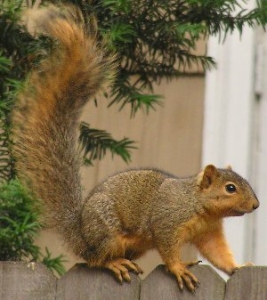Fox Squirrel
Biology
The Fox Squirrel is the largest species of tree squirrel throughout North America. They are classified as a medium to large sized rodent. They are colored with their upper body being brown-grey to brown-yellow with a usual brownish-orange underside.
Squirrels typically have a slim body, big eyes, soft fur, and a bushy tail. Their tail is used for communication and also for insulation against the colder temperatures. Squirrels have excellent vision, smell, and sense of touch. This specific species of squirrel uses scent marking as a means of communication.
Female squirrels normally reproduce twice a year. After a gestation period of 45 days, there are on average 3 young born. Their lifespan is normally 12 years for females and 8 years for males.
Habitat
This squirrels ideal habitat is forest filled with trees. Fox squirrels have two types of shelters: leaf nests and tree dens.
Threats
Squirrels may cause problems for homeowners by nesting in their attic, or in the exterior of the structure. They enter attics for warmth and safety; and often to birth, nest, and raise a litter. These pests are savage chewers and will gnaw their way through wooden structures to gain access to the interior. Once inside, they normally make scratching noises (usually at sunrise and sunset), leave droppings all over, and endanger all attic structures.
Squirrels are transmitters of human disease. It is very important not to handle wildlife by yourself. It is advised to have a professional handle the situation.
Habits
Squirrels are active during the day. Normally, you can see them on the ground foraging for food. They do not hibernate, but will normally spend long hours in their nest during the cold winter months. Squirrels are extremely vocal, they possess a vocal range that helps them communicate. Most of the sounds they make are considered an alarm call. Squirrels make them when they perceive a threat, it may sound like a bark, scream, chirp, or moan. They also communicate by flipping and flicking their tail around. Studies show that there are 2 separate types of alarm calls, one for an aerial threat, the other for a ground threat.
FEEDING PREFERENCES
Squirrels are omnivores, but they mostly eat plants, nuts, seeds, fungi, and fruits. Occasionally, they will eat insects, eggs, and even small snakes.
Prevention & Control
Due to the possible damage to your property and for your safety and health, wildlife issues are serious and should be handled professionally.
Structural Pest Squirrel Program
Our service technician will perform a thorough inspection on the exterior and interior of your structure to locate all problem areas and properly identify the pest you are having.
All programs are specially designed to target the pest that is infesting your structure.

